• VERTICAL GROWTH is the adaptation if humans have put them (and maintained them) in sunny locations.
ABOVE LEFT: October 2018 - Connie Barlow with HAZEL DELCOURT tree (about 7 feet tall).
ABOVE RIGHT: October 2018 - Connie with HENRY DAVID THOREAU tree (about 6 foot 8 inches tall).
__________
SITE-SPECIFIC LEARNINGS (as of 2018)
The Lake Junaluska locale offers insights for helping species recovery
...
1. ASSISTED MIGRATION - The plants seem to be disease-free at this latitude and elevation some 300 miles north of the historically native range in Florida.
2. ADAPTIVE GROWTH FORMS - If afforded the opportunity to grow in open sunlight, Torreya takes the form of a standard conifer (HAZEL DELCOURT and HENRY DAVID THOREAU). If the habitat is shaded subcanopy, its form is yew-like and growth is much slower (RACHEL CARSON and WILLIAM BARTRAM). Because Torreya genus is not a pioneer-sere taxon, only human intervention in cutting back overgrowth shade can maximize Torreya's growth potential and induce an upright form (and early seed production). As of 2018, no reproductive structures have been observed on even the tallest individuals (HAZEL DELCOURT and HENRY DAVID THOREAU).
3. ROOT-EATING RODENTS - Of the original 10 plantings in 2008, only 4 remain in 2018. All 6 deaths are attributable to tunneling, root-eating rodents. Because the same-age, same genetics Torreya planting at the Waynesville site has not been afflicted in the same way, the rodent problem must be site-specific. The forest garden (Corneille Bryan) is surrounded by pavement and homes, and there are two sources of boom-and-bust foods: (a) the Red and White Oaks have multi-year cycles of acorn masting, and (b) the house in the southwest corner of the garden forest has a birdfeeder overhanging its deck that drops seed only during this seasonally occupied summer community.
4. COMPETITIVE EXCLUSION BY RHODODENDRONS - Rhododendrons and Mountain Laurels are evergreen, subcanopy shrubs. Rhodies easily outpace Torreyas. (RACHEL and WILLIAM both have rhodies encroaching.)
5. REWILDING CONSTRAINTS - Unlike animals, plants cannot move to situate themselves in ideal circumstances — so we planters must attempt to find those macro sites (latitude, elevation, slope, aspect, forest type) and micro sites: rhododendron-free, deciduous canopy, extreme slopes. Until hundreds of seeds or seedlings are available for outplanting in each area, human interventions will remain necessary for ensuring speedy development of reproductive populations.
ACTIONS include: wire cages against surface rodents, removal of encroaching Rhododendrons, prompt removal of branch and treefalls. Autumn protection from antler rubbing will be important in deer habitat when a seedling reaches a height of 2 or 3 feet and until the prickly-leaf sapling loses its low branches. (Our planting site at Lake Junaluska shows no evidence of deer herbivory.) Both to deter deer and tunneling rodents, siting plants on extremely steep slopes is advised.
IDEALLY, in every "rewilding" site (distinct from full-sun, tended "orchard" sites), specimens should be numerous enough to have some managed for nearly full sunlight, some placed beneath a deciduous canopy but managed against branch-fall and rhodie intrusion, and others planted in various settings and left largely unmanaged — thus affording opportunities for learning more of Florida Torreya's natural history, preferences, and abilities to withstand and recover from setbacks. Visit the Propagate page for details.
 |
|
VIDEO 29: Florida Torreya to Lake Junaluska NC - 10th Anniversary
Ten years after the 2008 planting of ten potted seedlings as a first "assisted migration" project (reported on by Audubon Magazine), Connie Barlow returns to document ongoing results. The challenges, the successes, and the learnings are all topics covered here and also on the Lake Junaluska webpage. A key learning is how Torreya is capable of adapting its growth form to conditions of shade (horizontal, yew-like form) or abundant sunlight (standard conifer form).
31 minutes - filmed October 7, 2018
|
CORNEILLE BRYAN NATIVE GARDEN PLANTINGS
MAIN PAGE OF TORREYA REWILDING PHOTOESSAY
HOME PAGE